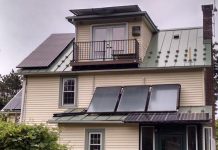This is the final article in a series on the WGA Energy Efficient Buildings Workshop.
On the morning of day two of the Western Governor’s Association Energy Efficient Buildings Workshop, the topic was performance contracting: a way of unlocking the power of a government entity’s utility budget to make energy improvements that pay for themselves, but might otherwise never receive the necessary capital.
Despite the dryness of the subject, the room seemed alive with active interest of the participants. Many of the workshop participants were government officials who are enthusiastic about energy efficiency, but also beaten down by the tyranny of the budget. For them, performance contracting must seem like the Holy Grail: a chance to make an improvement that not only improves their department’s bottom line, but a way to do it without having to fight for any precious new allocation from the overall budget.
In concept, performance contracting is a deal by which the government body contracts for a certain level of service (such as a level of building temperature and lighting) instead of buying the energy needed to run their building directly from the utility. The Energy Service Company, or ESCO, takes the money that would have gone to paying utility bills, and uses it to finance a loan which they use to make efficiency improvements to the facility. Part of the energy savings pay for the loan, and the rest are split between the ESCO and the government body as profit. As one presenter put it, it’s not a free lunch, it’s a lunch that you get paid to eat!
While the presentations focused on performance contracting for government entities, it’s also applicable in other situations (although many government entities enjoy the advantage of being able to borrow at municipal bond interest rates of 3-4%, there are many projects that can be profitably financed at much higher rates.) The presenters were also careful to emphasize that a performance contract can include renewable energy and other green or sustainable aspects, as well as energy efficiency improvements… the key is to find enough energy efficiency improvements to fund the more expensive parts of the package.
This area also has investment potential. While many ESCOs are private companies, quite a few ESCOs, as well as their financiers and suppliers are divisions of public firms. These companies are well placed to benefit from the raft of initiatives to improve the energy efficiency of government operations that is blossoming at the local level (some of which I discuss in the Political Developments article in this series.) A good place to look for companies involved in performance contracting is the membership of NAESCO, the National Association of Energy Service Companies. Prominent publicly-traded NAESCO members include:
Johnson Controls (NYSE:JCI), a company I included in my Blue Chip Alternative Energy Portfolio, in large part because of their activities in efficient buildings, and presenter at the conference.
Honeywell International (NYSE: HON)
Siemens Buildings Technologies, a division of Siemens AG (NYSE:SI), a company I also like for their presence in electricity transmission.
Trane, a leading A/C manufacturer and division of American Standard (NYSE: ASD)
Roger Flud TAC Energy Solutions (a private ESCO) of gave one of the more interesting presentations. His presentation was on the economic impact of energy efficiency in general and performance contracting in particular, with much of the information drawn from Saving Energy, Growing Jobs, by David Goldstein (you can read an excerpt here.) Goldstein debunks the myth that there must always be a choice between environmental protection and economic development; instead, the two can, with intelligent regulation, go hand in hand. A sample statistic: Saving $200 a month in electricity can fund a $2M project, which would create 83.5 man-years of work, plus potential manufacturing jobs if the equipment is manufactured locally.
I’m optimistic the other attendees learned many of the same things out of the workshop that I did, and that those who represent governments will do their parts to bring us intelligent regulation, which will allow better energy efficiency, lower greenhouse gas emissions, improved energy security, and enhanced economic development.
Links:
WGA Energy Efficient Buildings Workshop series overview.
Political Developments for Energy Efficiency in Western States
Energy Efficient Buildings workshop presentations.
DISCLOSURE: Tom Konrad and/or his clients have positions in these companies mentioned here: JCI, SI.
DISCLAIMER: The information and trades provided here are for informational purposes only and are not a solicitation to buy or sell any of these securities. Investing involves substantial risk and you should evaluate your own risk levels before you make any investment. Past results are not an indication of future performance. Please take the time to read the full disclaimer here.








